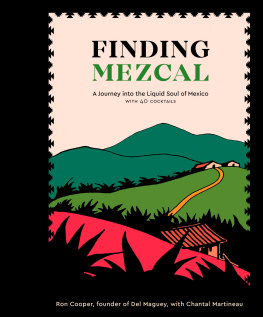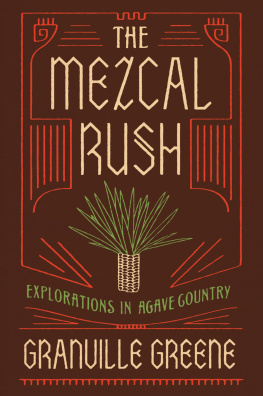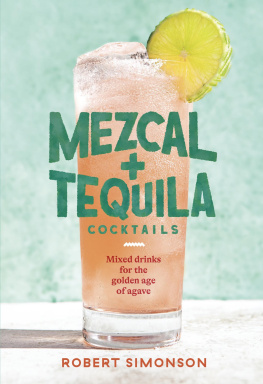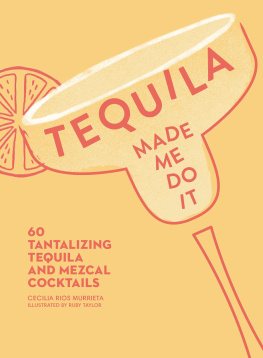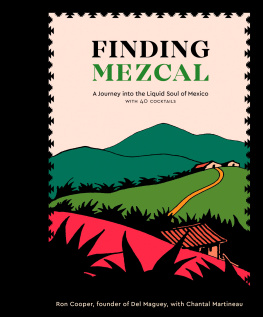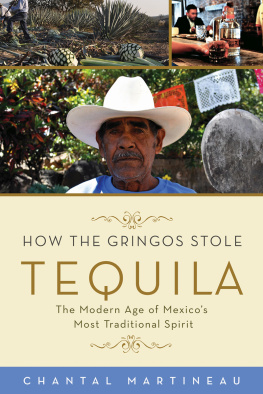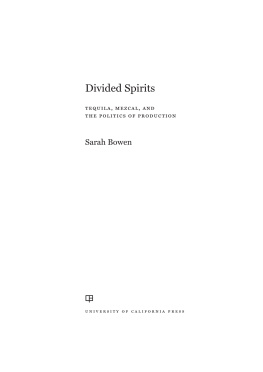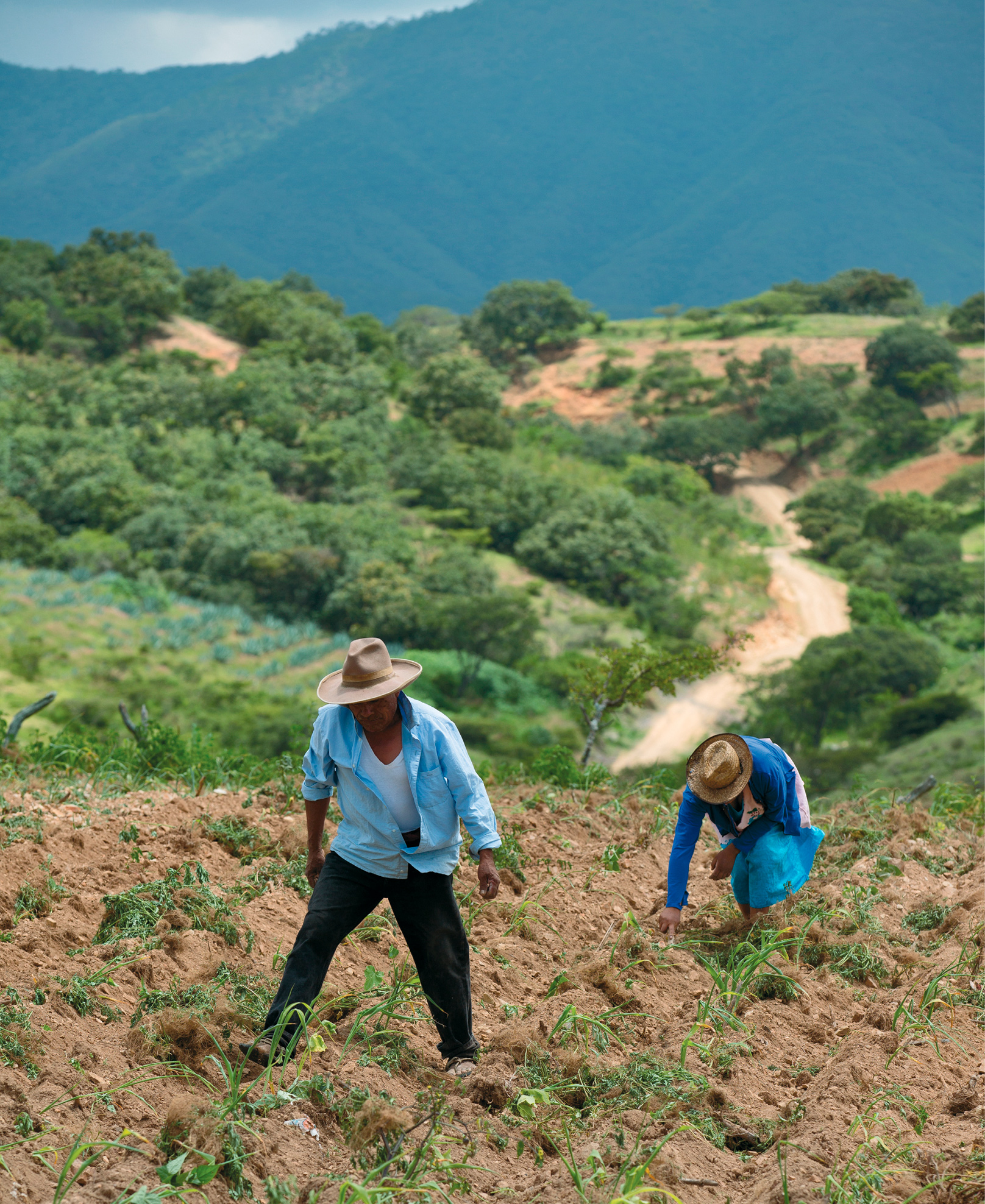
BUENA VISTA LAS MILPAS.
As they age, some people get sick. Others lose their eyesight or become arthritic. Me, Im losing my fingerprints.
I am baffled. Ive rubbed various creams on my fingertips in the hopes of preserving the fine grooves mapped out on them. But no matter what I do, my fingerprints keep fading. Theyre as smooth as eggshells. The scanners at the airport barely register my prints and I almost always end up with a big X on my printout at Global Entry. I sometimes worry about what would happen if I got arrested. If you cant take someones fingerprints, how do you identify them? Ni modo chato . I like the idea of treading lightly, leaving nothing behind. Ive learned to practice letting go. That way, everything becomes a gift.
Like San Pedro Taviche.
My friend Jorge Quiroz was a journalist for the daily newspaper in Oaxaca. We met when he started writing a column on mezcal. Wed get together to talk and taste. Eventually, he published a slender book on the spirit. One day, he told me about a remote village called San Pedro Taviche that made beautiful mezcal. Hed heard about it through a banker friend of his whose office was directly in front of the Central de Abastos market in downtown Oaxaca. The banker had met some of the village elders from San Pedro Taviche when they were in the city to fill out some official paperwork for a grant. The village kept getting bypassed for infrastructure improvements, like electrification, medical clinics, new roads, new schools. The elders were illiterate and unable to complete the required applications for government funds. The banker offered to help. They paid him in mezcal.
Jorge, his banker friend, and I set out for San Pedro Taviche together during Da de los Muertos. We were accompanied by my younger daughter, Sadie Ray, who was visiting, a writer-photographer duo from the UK, and a team of videographers from Mexico City shooting a short film called Fuego Verde . We took two vehicles. San Pedro Taviche is located in the most remote corner of the Ocotln district, in the deep south of Oaxacas Valles Centrales. From Teotitln, you have to go over three mountains to get there. The road was rocky and as dry as the desert. There were a few little springs along the way and the odd rancho here and there, but little else. Suddenly, the road dropped down into a tropical valley. When it came to a T, we could have sworn we were deep in the jungle. A guy walked around the corner, the first person wed seen in miles, and he was dressed in the most peculiar outfit. He wore a green felt sombrero with brightly colored peacock feathers sticking arched around the brim. He stared at us like we were from outer space. We hung a left, drove into the village, and came face-to-face with about fifty Indians. They all wore green felt sombreros with peacock feathers in them, Levis rolled up to their knees, and huaraches. They were playing volleyball.
It was nearly dusk as we rolled into this pueblito. From amid the group of men at play stepped the presidente municipal , who extended his hand to greet us. After initial introductions, he led us out of the village center to a large hill covered with cornfields. On top were four small single-room houses surrounding a patch of dirt forming a tiny plaza in the center. There we met Alberto Hernndez Luis, aka Don Beto, the man we had come to find. Don Beto had a round face and balding head and wore a wide, warm smile. We followed him into a ravine for about half a kilometer until we came to his palenque, a humble log-and-tin structure surrounded by banana trees. The still produced only 150 liters at a time. Don Beto made his mezcal from the wild magueys that grew in the hills nearby. He harvested wild espadn, tobal, tepextatewhatever was ripest and closest to him. Because the palenque was on a hill, it made use of gravity. The roasted pias were rolled from the horno, one at a time, down to a big black rock where two guys mashed it by hand with what looked like giant croquet mallets.
After our tour of the palenque, we headed back to Don Betos house. By this time, it was dark. No street lights. We could barely see the ground beneath our feet. Don Beto stored his mezcal in one of the four houses on the main square. His motherI guessed he was a bachelorwas at the doorway holding back a barking dog by the scruff of its neck. Don Beto beckoned us into another house, where I spotted the wildest altar Ive ever seen: just a couple of candles burning on the floor in the corner and a four-foot-high mass of orange wildflowers from the mountains. He poured us a taste of his mezcal out of a Coke bottle. It was unbelievable.
As we were talking and sipping out of the little clay cups Id distributed to everyone, my eyes drifted past our host to the walls of his little house. The entire thing was built out of giant maguey flower stalks. Quiotes. They were planted in the earth, these thick, dried stems. And where the wall met the roof, there was a row of cntaros , black clay jugs used for storing mezcal, lining the house all the way around. Id never seen anything like it. Snapping out of it, I asked what I could buy from him and we settled on twenty-five liters. I would drink it myself and share it with friends.
Can I buy some more? I inquired after a while. How much can you make for me? Ill buy it every year.
I can make a thousand liters a year.
Great! Lets make a deal, I said. When can I come back for more?
But it wasnt going to be that easy. Don Beto said, Wait a minute. Easy does it. And I knew I wasnt going to like what came next. I cant sell to you unless you buy from the other two producers in this village.
Oh. But I never tasted their mezcal. I like your mezcal, I told him.
I know, he said. But if you dont buy from them, Ill get the mal de ojo the evil eyeand Ill die.
What can you say to that? I thanked him and told him I loved his mezcal, but that Id have to think about his proposal.
Over the next couple of years, I shared and drank twenty-five liters of San Pedro Taviche. Three or four years later, I went back and Don Beto was happy to see me. I bought more mezcal from him to take home, but not enough to bottle. In nine years, I went back to visit with Don Beto four more times. Sometimes, I took guests with me. Each time, I held out hope that I might finally get him to sell me enough mezcal to bottle for Del Maguey. Each time, he reiterated his terms.
A few years ago, I went with Cosme, Panchos father. Don Beto invited us into his home where he pulled out an emerald green five-gallon jug of mezcal. He poured it into smaller plastic water bottles and served us from those. We sat and sipped out of little clay cups as he shared with us that this was his last mezcal.
Its over, he said. My knees are gone. I cant go up into the forest anymore to harvest the wild espadn, the wild tobal, and the wild tepextate. I cant even walk up through the arroyo to my palenque.
I was crushed.
Don Beto, thank you so much, I told him. Youve been so wonderful. If I can ever help you, just tell me. And then it occurred to me that I could help this sweet man. I told him he could get an operation on his knees. I offered to pay for it. He could trade me mezcal in return. He never gave me an answer.
Instead, he said, My brother always wanted to buy my palenque, but it was my profession. How could I sell him my palenque? But now that I cant walk up there anymoreHere. Lets have another. He filled the water bottle anew and we drank that, too. Between sips, we paid our respects to the Virgin of Juquila, whose picture hung above his wild altar.

